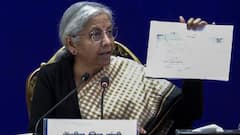New Tax Regime Vs Old Tax Regime: Which Is More Attractive And Works Better? Have A Look
Finance Minister Nirmala Sitharaman presented the last full Budget of the Modi government and announced individuals earning up to Rs 7 lakh per annum will not have to pay any tax under the new tax regime

As Finance Minister Nirmala Sitharaman on Wednesday announced individuals earning up to Rs 7 lakh per annum will not have to pay any tax under the new tax regime, the question arises which one is suitable and works better -- new tax regime or old tax regime. According to her Budget speech, taxpayers with annual income of up to Rs 7 lakh will save Rs 33,800 in taxes. However, the old tax regime that comes with exemptions on certain investments and expenditures will remain attractive for taxpayers who pay house rent or have a home loan. There is something to cheer for the Indian middle class as they have been reeling from the impact of inflation, layoffs, and the pandemic.
The minister clarified, "Currently, those with income up to Rs 5 lakh do not pay any income tax in both old and new tax regimes. I propose to increase the rebate limit to Rs 7 lakh in the new tax regime. Thus, persons in the new tax regime with income up to Rs 7 lakh will not have to pay any tax."
According to a finance ministry official, the new regime would be advisable for those whose deductions and exemption claims are less than Rs 3.75 lakh annually. "So, a taxpayer who claims deductions less than Rs 3.75 lakh while filing the annual I-T returns will be advised to opt for the new tax regime as declared in the Budget. They will stand to benefit by enjoying the reduced tax slab as stated in the Budget," the officer said. The new tax regime does not have many concessions which the old regime has though standard deduction has been introduced to the new regime for the first time. The new tax regime makes income upto Rs 7 lakh annually tax free. But for those who are much higher than Rs 7 lakh, the question is whether to shift to the new regime as they may end up paying more taxes with limited exemptions available.
Let’s go into the details
An individual earning Rs 7 lakh (and not availing any deductions) were paying Rs 52,500 as taxes in the old regime. However, this has now been reduced to nil in the new tax regime. Even if he was claiming deduction of Rs 3.5 lakh under HRA (Rs 1.25 lakh), Section 80C (Rs 1.5 lakh), 80D (Rs 25,000), and standard deduction (Rs 50,000), he would have been paying Rs 5,000 in taxes in the old regime. So, he saves anywhere between Rs 5,000 to Rs 52,500. Here, it may be noted that assuming deduction of Rs 3.5 lakh out of income of Rs 7 lakh is on the higher side. The savings of this segment of lower middle class is likely to be more towards the middle of the range of Rs 5,000 - Rs 52,500 which is Rs 25,000 or so, around Rs 2,000 per month.
Check the new income tax slabs
- Income Tax Rate
- 0-3 Lakh Nil
- 3-6 Lakh 5%
- 6-9 Lakh 10%
- 9-12 Lakh 15%
- 12-15 Lakh 20%
- Over 15 Lakh 30%
There is a confusion among the general public regarding the slabs of the new income tax. If the slabs are taxing income from Rs 3 lakh-Rs 6 lakhs, then how is it possible for an individual to pay 0 tax on an income of Rs 7 lakh? According to tax experts, if an individual earns upto Rs 7 lakh, he/she doesn't have to pay any income tax. With the standard deduction of Rs 50,000 now applicable to people in the new income tax regime, people with annual income of up to Rs 7.5 lakh are out of the tax net. The standard deduction was earlier available to only those who opted for the old income tax regime. The minister has reduced the slabs in the new income tax regime and made it the "default regime". Taxpayers will now have to opt for the old tax regime.
In the new income tax regime, people earning Rs 9 lakh a year will be taxed at 5 per cent and will see a tax outgo of Rs 45,000. The tax paid will be 25 per cent less than the Rs 60,000 paid earlier. People earning up to Rs 15 lakh a year will be levied a tax of 10 per cent and end up paying Rs 1.5 lakh. This is, in fact, a reduction of 20 per cent from the earlier tax liability of Rs 1.87 lakh. So, for those not leaning on tax-saving investments, a switch to the new regime is being seen as a prudent move.
However, the general consensus of experts is that if a person has made a heavy investment in tax-saving instruments, the old income tax regime makes sense. A taxpayer can save Rs 2 lakh on interest paid on a home loan under Section 24b. That deduction goes up to Rs 2.5 lakh under Section 80EE if the house is under 'affordable' category. Taking all these into account, an indiviual has to chose the tax regime wisely.
Expert voices
Siddharth Maurya, resource specialist, Fund Management, said, the Union Budget 2023-24 is more focused on reviving the domestic demand and public investments to propel growth as the world is gripping in the fear of a possible recession. The announcements made were mostly in line with the market expectations like a focus on job creation, increased spending on infrastructure, reigning in the deficit, and bringing the economy back on track with few misses. However, the budget was muted on any direct relief to the investors from STT or other taxes levied on capital gains. The fiscal deficit target has been lowered to 5.9 in 2023-24 to achieve the target of 4.5 percent in 2025-26 has boosted the investors confidence.
Shreya Jaiswal, CA and finfluencer, said, considering the high inflation rate of the country, the global recession, post-pandemic recovery, and the upcoming 2024 election there is no doubt that all eyes were set on today’s budget speech. The 2024 Budget is a perfect example of what we call a Populist Budget. From promoting the MSMEs to continue driving the startup ecosystem in India and favoring domestic tourism over international tourism, the government is also betting big on India emerging as a superpower amid the global recession. The direct tax proposals received the loudest cheer not only in the Parliament but across the nation. It would be safe to say the personal tax proposals are indeed intended towards luring the middle class for the upcoming elections. The government has very closely monitored the middle class’s budget expectations for the last 5 years and has fulfilled them all at once. Increasing the tax rebate to Rs 7 lakhs from the existing Rs 5 lakhs, increasing the basic tax exemption limit to Rs 3 lakhs from the existing Rs 2 lakhs, and increasing the exemption limit on leave encashment from the existing Rs. 3 lakhs to a whooping Rs 25 lakhs and considering all the other several relaxations that were announced, I can see the middle-class rejoicing. While on one hand, we see the direct tax collections going down, on the other hand, you can also expect an increase in the GST collections considering that there will now be surplus funds in the hands of the public. What effect it will have on inflation, only the coming days will tell.
Amit Gupta, MD, SAG Infotech, said, around 45 per cent of ITRs are completed within 24 hours, and the common ITR form will be available soon. Furthermore, to enhance the IT grievance redressal mechanism, and to increase the presumptive taxes limitations at Sec 44AD - Rs3 crore and Sec 44ADA - Rs 75 lakh. Income tax incentives for businesses with start-ups have been extended by a year till 2024. - Incorporation Date - from 31.3.2023 to 31.3.2024 - 80IAC. Small income tax appeals will be handled by 100 joint commissioners. Furthermore, startups can carry forward their lost benefit from 7 to 10 years. The refund has been enhanced to Rs 7 lakh under the new tax scheme.
Neeru Ahuja, partner, Deloitte India, said individuals who get house rent allowance (HRA) from their employer and pay rent for their accommodation are likely to pay lower tax under the old tax regime. In addition to HRA deductions, individuals can also claim deduction on interest on their home loan under the old tax regime if the distance between the two accommodations are more than 40 km, she said.
Trending News
Top Headlines












































